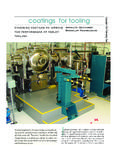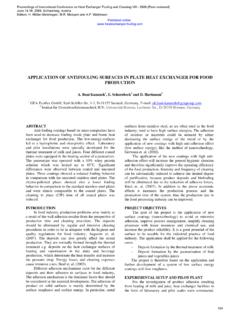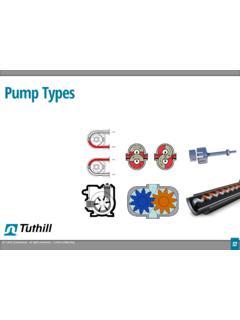Transcription of Tableting Specificatin Manual, 7 Edition Section 4 ...
1 Tableting Specificatin Manual, 7th Edition Section 4 tooling Coatings By Arnold H. Deutchman, Section 4: tooling Coatings Specialized coatings and treatments can be used to enhance the properties and performance of tool steels or to solve specific problems. Coatings normally are applied to tool steels to (1) improve wear resistance to combat abrasion from aggressive granules, (2) improve corrosion resistance, and (3) improve lubricity for sticky products. Today, a wide range of specialized coatings is available, and new solutions are being developed constantly. Some of the coatings are suitable for the tablet tooling application; however, tooling users must take great care in selecting coatings and seek advice from their tooling manufacturer regarding the suitability of a coating and its interface with the base material of the tooling .
2 Table 14 lists the most common treatments and their function(s). TABLE 14. FUNCTION(S) OF COMMON STEEL COATINGS AND TREATMENTS. IMPROVED IMPROVED IMPROVED. coating /TREATMENT WEAR CORROSION LUBRICITY. RESISTANCE RESISTANCE. HARD CHROMIUM PLATING . PVD TITANIUM NITRIDE . (TiN). PVD CHROMIUM NITRIDE . (CrN). ELECTROLESS . IBED (TiN, Cr2N, Cr, Al2O3) . NOTES: 1. ALL TREATMENTS HAVE BEEN TRIED IN CERTAIN APPLICATIONS AND HAVE BEEN. SUCCESSFUL IN SOME AREAS. 2. THE PERFORMANCE OF THESE TREATMENTS MAY. NOT ALWAYS JUSTIFY THEIR COST. INITIALLY, THE TREATMENTS SHOULD BE. APPLIED ON AN EXPERIMENTAL BASIS.
3 3. CONSULT YOUR tooling MANUFACTURER FOR SPECIFIC DATA FOR THESE. TREATMENTS. = teflon; IBED = ion beam enhanced deposition. coating Processes Of the many coating processes in the industrial marketplace three have been used for Tableting tooling . The processes are chemical plating, physical vapor deposition (PVD), and ion beam enhanced deposition (IBED). All of the various coatings available are deposited by one of these three basic processes. Metallic coatings such as nickel (Ni) and chromium (Cr) are deposited either by electroplating (Cr), or electroless plating (Ni). Materials such as Boron (B), and Teflon (PTFE), can be added to nickel (Ni) to enhance plated coating hardness and coating lubricity, respectively.
4 Processing temperatures during plating are below 200 F, but the coated tool must be baked post-plating at higher temperatures (375 F) to prevent hydrogen embrittlement (Cr), or at temperatures between 650 F and 900 F to achieve full hardness (Ni). Hard refractory nitride coatings such as titanium nitride (TiN) and chromium nitride (CrN), and diamond-like carbon (DLC) are usually deposited by physical vapor deposition (PVD) processes. Double layer PVD coatings consisting of a layer of TiN with a CrN overcoating are also possible, and are termed superlattice coatings. The PVD processing temperature must be 900 F or above to ensure good adhesion and optimum coating properties.
5 At these temperatures the bulk tool material will soften and precision dimensions will distort. These nitride hardcoatings can also be deposited by the low temperature ion beam enhanced deposition (IBED). process. coating temperatures do not exceed 200 F, which is low enough to eliminate the danger of dimensional distortion or bulk softening of the punch. coating adhesion is guaranteed by first forming a layer (termed a case Reprinted from Tableting Specification Manual, 7th Edition , American Pharmacists Association, Washington, DC, 2006. Page 1. Tableting Specificatin Manual, 7th Edition Section 4 tooling Coatings By Arnold H.)
6 Deutchman, layer) in the surface of the punch, and then growing the coating out from the case layer. The major features of all three coating processes are summarized in Table 15. TABLE 15. coating PROCESS COMPARISONS. FEATURE PLATING PVD IBED. MECHANICAL OR. DEGREASING & DEGREASING &. PRETREATMENT CHEMICAL. CLEANING CLEANING. ROUGHENING. PLATING: <300 F. TEMPERATURE 900-1200 F <200 F. BAKING: 300-900 F. ADHESION. MECHANICAL CHEMICAL METALLURGICAL. MECHANISM. COATINGS Ni, Cr, Ni(B), Ni, Cr, TiN, Cr2N, TiN, CrN, DLC. AVAILABLE Ni(PTFE) Al2O3. POST- coating . REQUIRED MAY BE REQUIRED NOT REQUIRED.
7 POLISHING. General Requirements for Tablet Tool Coatings Coatings, and coating processes used to apply them, must not compromise the original properties of the punches. Key properties of precision punches include surface-related features and bulk-related features, and are listed in Table 16. All of these features must be maintained and/or optimized if the coating applied is to be successful.. Surface-Related Properties First of all, coatings must not degrade the original spectral (shiny, highly reflective) finish on the cup surface. Coatings that roughen the surface, even though they may be hard, will act to enhance mechanical adhesion of powders.
8 The coatings must be harder that the bulk material in order to provide enhanced wear-resistance, and they must adhere well to the cup surface so that they do not chip or flake away. The coatings must be free of pinholes or voids in order to act as barriers to corrosion. And the coating material must be chemically inert in order to satisfy FDA current Good Manufacturing Processes (cGMP) Bulk-Related Properties The bulk hardness of the punch must not be affected by the coating process. High processing temperatures can soften the punch, thus weakening key areas such as the land and punch head.
9 The physical dimensions of the punch must also be maintained during coating . Again excess heat can easily distort key dimensions such as overall length so that they exceed critical tolerances. And certain plating processes apply coatings non- uniformly producing excess coating buildup predominantly on sharp land edges and embosses. Reprinted from Tableting Specification Manual, 7th Edition , American Pharmacists Association, Washington, DC, 2006. Page 2. Tableting Specificatin Manual, 7th Edition Section 4 tooling Coatings By Arnold H. Deutchman, TABLE 16. ENGINEERING REQUIREMENTS FOR TABLET PUNCH COATINGS.
10 FEATURE BENEFITS. SURFACE-RELATED PROPERTIES. NON-DEGRADED SURFACE NO MECHANICAL INTERLOCKING OF. FINISH IN CUP POWDER. INCREASED SURFACE. IMPROVED WEAR-RESISTANCE. HARDNESS. coating ADHESION NO FLAKING OR CHIPPING. NO PITS/VOIDS IN THE coating CONTINUOUS CORROSION BARRIER. coating CHEMICALLY INERT MEETS FDA cGMP GUIDELINES. BULK-RELATED PROPERTIES. BARREL HARDNESS NO TEMPERING/SOFTENING. OVERALL DIMENSIONS NO DISTORTION. LAND NO ASYMMETRIC BUILDUP. Relative Wear Resistance of tooling and coating Materials Resistance to abrasive wear is one of the key features required of coatings applied to the working surfaces of Tableting punches.






